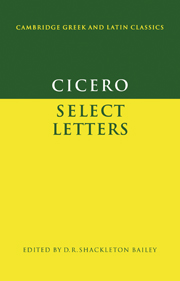Introduction
Published online by Cambridge University Press: 05 June 2012
Summary
CICERO
Thanks to the survival of many of his private letters more is known of Cicero in later life than of any other personality in Greco-Roman antiquity. The same applies to the period which they cover, the last twenty years of the Roman republic. Conversely, much of Cicero's correspondence will not be properly understood without some knowledge of his personal life and its historical background. Innumerable accounts of both have been written in greater or less detail. Here they can be sketched only very briefly.
M. Tullius Cicero was a native of Arpinum (Arpino), an ancient Volscian township in the hills about seventy miles east of Rome, which had received Roman citizenship early in the second century. His date of birth was 3 January 106. The family was old, wealthy, and locally prominent, with an estate near the town which Cicero inherited in due course. He was the eldest son. A second, Quintus, followed about two years later. There were no daughters. Not much is known of the parents. M. Cicero senior was something of an invalid with bookish tastes; references to him in his son's works are few and colourless, and there are none at all to his wife Helvia. But she is described elsewhere as well-born and well-behaved, and a random reminiscence in a letter of Q. Cicero presents her as a strict and careful housewife.
- Type
- Chapter
- Information
- Cicero: Select Letters , pp. 1 - 18Publisher: Cambridge University PressPrint publication year: 1980



